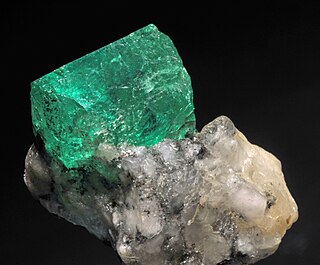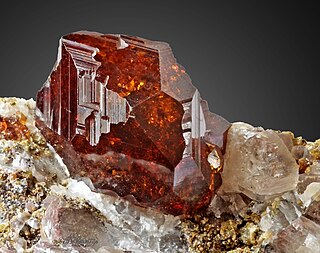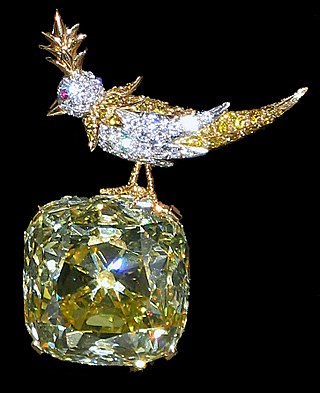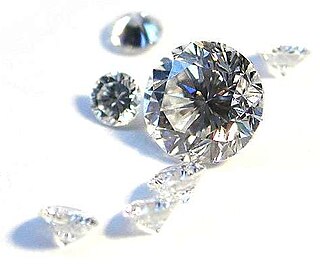
Emerald is a gemstone and a variety of the mineral beryl (Be3Al2(SiO3)6) colored green by trace amounts of chromium or sometimes vanadium. Beryl has a hardness of 7.5–8 on the Mohs scale. Most emeralds have lots of material trapped inside during the gem's formation, so their toughness (resistance to breakage) is classified as generally poor. Emerald is a cyclosilicate.

A gemstone is a piece of mineral crystal which, when cut or polished, is used to make jewelry or other adornments. However, certain rocks and occasionally organic materials that are not minerals are also used for jewelry and are therefore often considered to be gemstones as well. Most gemstones are hard, but some soft minerals are used in jewelry because of their luster or other physical properties that have aesthetic value. Rarity and notoriety are other characteristics that lend value to gemstones.

Sapphire is a precious gemstone, a variety of the mineral corundum, consisting of aluminium oxide (α-Al2O3) with trace amounts of elements such as iron, titanium, cobalt, lead, chromium, vanadium, magnesium, boron, and silicon. The name sapphire is derived via the Latin sapphirus from the Greek sappheiros (σάπφειρος), which referred to lapis lazuli. It is typically blue, but natural "fancy" sapphires also occur in yellow, purple, orange, and green colors; "parti sapphires" show two or more colors. Red corundum stones also occur, but are called rubies rather than sapphires. Pink-colored corundum may be classified either as ruby or sapphire depending on locale. Commonly, natural sapphires are cut and polished into gemstones and worn in jewelry. They also may be created synthetically in laboratories for industrial or decorative purposes in large crystal boules. Because of the remarkable hardness of sapphires – 9 on the Mohs scale (the third hardest mineral, after diamond at 10 and moissanite at 9.5) – sapphires are also used in some non-ornamental applications, such as infrared optical components, high-durability windows, wristwatch crystals and movement bearings, and very thin electronic wafers, which are used as the insulating substrates of special-purpose solid-state electronics such as integrated circuits and GaN-based blue LEDs. Sapphire is the birthstone for September and the gem of the 45th anniversary. A sapphire jubilee occurs after 65 years.

Garnets are a group of silicate minerals that have been used since the Bronze Age as gemstones and abrasives.

A ruby is a pinkish red to blood-red colored gemstone, a variety of the mineral corundum. Ruby is one of the most popular traditional jewelry gems and is very durable. Other varieties of gem-quality corundum are called sapphires. Ruby is one of the traditional cardinal gems, alongside amethyst, sapphire, emerald, and diamond. The word ruby comes from ruber, Latin for red. The color of a ruby is due to the element chromium.

Tanzanite is the blue and violet variety of the mineral zoisite, caused by small amounts of vanadium. Tanzanite belongs to the epidote mineral group. Tanzanite is only found in Simanjiro District of Manyara Region in Tanzania, in a very small mining area approximately 7 km (4.3 mi) long and 2 km (1.2 mi) wide near the Mererani Hills.

Amateur geology or rock collecting is the non-professional study and hobby of collecting rocks and minerals or fossil specimens from the natural environment. In Australia, New Zealand and Cornwall, the activities of amateur geologists are called fossicking. The first amateur geologists were prospectors looking for valuable minerals and gemstones for commercial purposes. Eventually, however, more people have been drawn to amateur geology for recreational purposes, mainly for the beauty that rocks and minerals provide.

Tsavorite or tsavolite is a variety of the garnet group species grossular, a calcium-aluminium garnet with the formula Ca3Al2Si3O12. Trace amounts of vanadium or chromium provide the green color.

Demantoid is the green gemstone variety of the mineral andradite, a member of the garnet group of Minerals. Andradite is a calcium- and iron-rich garnet. The chemical formula is Ca3Fe2(SiO4)3 with chromium substitution as the cause of the demantoid green color. Ferric iron is the cause of the yellow in the stone.

The Gemological Institute of America (GIA) is a nonprofit institute based in Carlsbad, California. It is dedicated to research and education in the field of gemology and the jewelry arts. Founded in 1931, GIA's mission is to protect buyers and sellers of gemstones by setting and maintaining the standards used to evaluate gemstone quality. The institute does so through research, gem identification and diamond grading services and a variety of educational programs. Through its library and subject experts, GIA acts as a resource of gem and jewelry information for the trade, the public and media outlets.

Grossular is a calcium-aluminium species of the garnet group of minerals. It has the chemical formula of Ca3Al2(SiO4)3 but the calcium may, in part, be replaced by ferrous iron and the aluminium by ferric iron. The name grossular is derived from the botanical name for the gooseberry, grossularia, in reference to the green garnet of this composition that is found in Siberia. Other shades include cinnamon brown (cinnamon stone variety), red, and yellow. Grossular is a gemstone.

The Tiffany Yellow Diamond is one of the largest yellow diamonds ever discovered. Its carat weight was originally 287.42 carats in the rough when discovered in 1878 in the Kimberley mine in South Africa. It was cut into a cushion shape of 128.54 carats with 82 facets—24 more than a traditional round brilliant—to maximize its brilliance. The facet pattern features eight needle-like facets pointing outward from the culet (bottom) facet. Jewelry and diamond historian Herbert Tillander refers to this as a "stellar brilliant cut", and lists the gem in his book, Diamond Cuts in Historic Jewelry – 1381 to 1910 (1995), among other such diamonds: the Cullinan Diamond, the Koh-i-Noor, the Polar Star, the Wittelsbach, and others.

Diamond is one of the best-known and most sought-after gemstones. They have been used as decorative items since ancient times.
Campbell R. Bridges was a Scottish-born Kenyan gemologist.
John Sinkankas was a Navy officer and aviator, gemologist, gem carver and gem faceter, author of many books and articles on minerals and gemstones, and a bookseller and bibliographer of rare books.

The DeYoung Red Diamond is a 5.03-carat unmounted rare red diamond. It is the third-largest red diamond in the world, and the only one on public display. Sydney DeYoung obtained the diamond, which was mistaken for a garnet, at a flea market. The diamond was given to the Smithsonian Institution after DeYoung's death in 1986.
The Allison and Roberto Mignone Halls of Gems and Minerals are a series of exhibition halls at the American Museum of Natural History on the Upper West Side in Manhattan, New York City. The halls opened on June 12, 2021, as a complete redesign of their predecessors, the Harry Frank Guggenheim Hall of Gems and Minerals and Morgan Memorial Hall of Gems. The halls feature thousands of rare gems, mineral specimens and pieces of jewelry.














